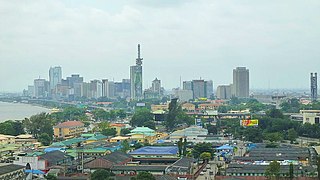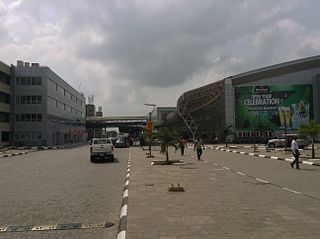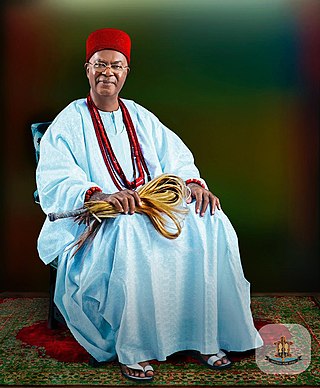The Water House is one of the few remaining residential buildings that showcases Brazilian architectural style in Nigeria. The building is located in Kakawa street, downtown Lagos, Lagos Island and built in the 19th century during the era of the Lagos colony. It was owned and inhabited by Candido Da Rocha. [1] [2] [3] [4]

Lagos or Lagos City is the most populous city in Nigeria, with an estimated population of 21 million in 2015. Lagos is the most populous urban area in Africa. Lagos was the national capital of Nigeria until December 1991 following the government's decision to move their capital to Abuja in the centre of the country. Lagos is a major African financial centre and is the economic hub of Lagos State and Nigeria at large. The city has a significant influence on commerce, entertainment, technology, education, politics, tourism, art, and fashion in Africa. Lagos is also among the top ten of the world's fastest-growing cities and urban areas. The megacity has the fourth-highest GDP in Africa and houses one of the largest and busiest seaports on the continent. Due to the large urban population and port traffic volumes, Lagos is classified as a Medium-Port Megacity.

Ikeja is the capital city of Lagos State in southwestern Nigeria. Its population, as of the 2006 census, is 313,196. Prior to the emergence of military rule in the early 1980s, Ikeja was a well planned, clean and quiet residential and commercial town with shopping malls, pharmacies and government reservation areas. It lies 10.5 miles (17 km) northwest of Lagos city. The Murtala Muhammed International Airport is located in the city. Ikeja is also home to Femi Kuti's Africa Shrine and Lagbaja's Motherland, both venues for live music. Its Ikeja City Mall is the largest mall on the Lagos State mainland. Ikeja also has its own radio station, broadcasting both in English and in Yoruba.

Lagos State is a state in southwestern Nigeria. Of the 36 states, it is both the most populous and smallest in area. Bounded to the south by the Bight of Benin and to the west by the international border with Benin for ten km, Lagos State borders Ogun State to the north for about 283 km, making it the only Nigerian state to border only one other state. Named for the city of Lagos—the most populous city in Africa—the state was formed from the Western Region and the former Federal Capital Territory on 27 May 1967.

Lagos Island is the principal and central Local Government Area (LGA) in Lagos, Nigeria, it was the capital of Lagos State until 1957. It is part of the Lagos Division. As of the preliminary 2006 Nigerian census, the LGA had a population of 209,437 in an area of 8.7 km2. The LGA only covers the western half of Lagos Island; the eastern half is simply referred to as Lagos Island East LCDA.

Paulo Mendes da Rocha was a Brazilian architect.
Holy Child College is a Catholic secondary school for girls in Lagos, Nigeria. It was set up on 9 April 1945 by the Society of the Holy Child Jesus (SHCJ) and run by the Roman Catholic Archdiocese of Lagos. It is located in South-West Ikoyi on the cusp of Obalende and Keffi; next to its brother school St Gregory's College, Lagos. Holy Child College consists of three years of Junior Secondary School (JSS) and three years of Senior Secondary School (SSS) as part of the 6-3-3-4 educational system in Nigeria, and the West African Senior School Certificate Examinations, allowing eligibility for graduation.

The Badagry in Bariga, a suburb of Lagos in Lagos State, is the oldest secondary school in Nigeria, founded on 6 June 1859 by the Church Missionary Society. For decades it was the main source of African clergymen and administrators in the Lagos Colony.

Lagos Colony was a British colonial possession centred on the port of Lagos in what is now southern Nigeria. Lagos was annexed on 6 August 1861 under the threat of force by Commander Beddingfield of HMS Prometheus who was accompanied by the Acting British Consul, William McCoskry. Oba Dosunmu of Lagos resisted the cession for 11 days while facing the threat of violence on Lagos and its people, but capitulated and signed the Lagos Treaty of Cession. Lagos was declared a colony on 5 March 1862. By 1872, Lagos was a cosmopolitan trading centre with a population over 60,000. In the aftermath of prolonged wars between the mainland Yoruba states, the colony established a protectorate over most of Yorubaland between 1890 and 1897. The protectorate was incorporated into the new Southern Nigeria Protectorate in February 1906, and Lagos became the capital of the Protectorate of Nigeria in January 1914. Since then, Lagos has grown to become the largest city in West Africa, with an estimated metropolitan population of over 9,000,000 as of 2011.

Sérgio da Rocha is a Brazilian prelate of the Catholic Church who has been a cardinal since 2016 and the Archbishop of São Salvador da Bahia since 11 March 2020. He has been a bishop since 2001, first as auxiliary bishop of Fortaleza from 2001 to 2007, coadjutor and then archbishop of Teresina from 2007 to 2011, and archbishop of Brasília from 2011 to 2020. He is a member of the Council of Cardinals.
Brazilians in Nigeria, Amaros or Agudas consist of the descendants of freed Afro-Brazilian slaves who left Brazil and settled in Nigeria. The term Brazilians in Nigeria can also otherwise refer to first generation expatriates from Brazil.

The Saro, or Nigerian Creoles of the 19th and early 20th centuries, were Africans that were emancipated and initially resettled in Freetown, Sierra Leone by the Royal Navy, which, with the West Africa Squadron, enforced the abolition of the international slave trade after the British Parliament passed the Slave Trade Act 1807. Those freedmen who migrated back to Nigeria from Sierra Leone, over several generations starting from the 1830s, became known locally as Saro(elided form of Sierra Leone, from the Yoruba sàró). Consequently, the Saro are culturally descended from Sierra Leone Creoles, with ancestral roots to the Yoruba people of Nigeria.
Chief Candido Joao Da Rocha was a Nigerian businessman, landowner and creditor who owned Water House on Kakawa Street, Lagos Island, Lagos, and was the proprietor of the now defunct Bonanza Hotel in Lagos. He held the chieftaincy title of the Lodifi of Ilesa.
Moses Da Rocha was a Nigerian medical doctor, journalist and politician. He was among a number of medical doctors such as Africanus Horton, Orisadipe Obasa and John K. Randle who combined medical practice and politics. He founded the Union of Young Nigerians in 1923 just before the elections into the Legislative Council.

Ilojo Bar, also called Olaiya House or Casa da Fernandez, was a Brazilian-styled historic building located near Tinubu Square in Lagos Island, Lagos State, Nigeria. It was originally built as a bar and restaurant in 1855 by the Fernandez family who employed returning ex-slaves who had mastered the art of building while in South America. Ilojo Bar was subsequently sold to Alfred Omolana Olaiya of the Olaiya family in 1933 and was declared a national monument in 1956 by the National Commission for Museums and Monuments.

The architecture of Lagos is an eclectic mix of different types, styles and periods. Buildings range from traditional vernacular architecture to tropical modern architecture or a mixture. The oldest European-styled buildings date back to the 17th century. Elements of Portuguese architecture introduced by returnee ex-slaves from Brazil and the Caribbean, although present all over the city, predominates in places like: Lagos Island, Surulere and Yaba Municipalities. Colonial-styled architecture flourished during the Lagos Colony. The Lagos skyline is a mixture of modern high rise buildings, skyscrapers, dilapidated buildings and slums. Lagos has the tallest skyline in Nigeria. Skyscraper construction commenced in the 1960s. Several office and mixed-use buildings have been built by international developers and private equity firms. Modern buildings and structures have been a continuous development until date.

Tonye Patrick Cole is a Nigerian billionaire businessman, he is the co-founder and former Group Executive Director of Sahara Group an energy conglomerate with operations spanning the entire energy chain in Nigeria and neighbouring West African countries to East Africa and beyond. The Group operates in 38 countries around the world with over 4,000 employees and annual turnover of $11 billion. He was directly responsible for building the Group's global expansion and upholding her corporate governance principles, maintaining her status with global institutions like the World Economic Forum, where he was a key member of Partnering Against Corruption Initiative (PACI), The United Nations), where he was a pioneer member of the advisory board of the Private Sector Advisory Group for the UNDP Sustainable Development Group Fund (SDG-F), The African Philanthropy Forum amongst others.

Architecture of Nigeria was historically influenced by environmental conditions as well as social and cultural factors. The coming of missionaries and political changes brought about by colonialism precipitated a change in architectural style and utility of buildings. A Gothic revival style was adopted for early churches built in the colony of Lagos. A one or two-storey timber house building made with pre-fabricated material components and designed with the influence of classic antiquity styles served as mission house for the missionaries. Colonial residents working for the Public Works Department introduced a variant of neoclassical architecture to designs of government buildings and private residencies.

The social structure in Nigeria is the hierarchical characterization of social status, historically stratified under the Nigerian traditional rulers and their subordinate chiefs, with a focus on tribe and ethnicity which continued with the advent of colonization.

Yoruba architecture describes the architectural styles of the Yoruba people of West Africa, dating back to approximately the 8th century. and lasted up to and beyond the colonial period beginning in the 19th century CE.
{{cite book}}: |work= ignored (help)